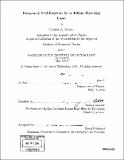Frequency stabilization for a 486nm dye-ring laser
Author(s)
Sievers, Charles A. (Charles Anders), 1979-
DownloadFull printable version (1.534Mb)
Other Contributors
Massachusetts Institute of Technology. Dept. of Physics.
Advisor
Thomas Greytak.
Terms of use
Metadata
Show full item recordAbstract
For my thesis, I worked towards using two reference cavities to provide frequency stabilization to a 486nm dye-ring laser. After a doubling cavity doubles the frequency to 243nm, the laser beam is used to excite ground state hydrogen to the 2S state: the first step of an experiment to accurately measure the 2S-NS transitions of hydrogen and measure the Lamb shift and Rydberg's constant. Two stabilization cavities were used to prevent the frequency from drifting and to narrow the laser's line-width. I aligned the majority of the optics and coupling light into fiber-optic cables and Fabrey-Perot cavities. Coupling light into a high finesse Fabrey-Perot cavity requires matching the radius of curvature of constant phase of the laser with the geometry of the cavity. To do this, I first measured the physical properties of the laser beam and then numerical arrived at a solution using two lenses to match the conditions imposed by the cavity's geometry. I aligned the cavity and then observed a Pound-Drever-Hall error signal. This error signal will be fed back into the laser to stabilize the frequency. It is anticipated that when the electronics to utilize the error signals are completed, the laser frequency will be stabilized to a hundred hertz, an four order of magnitude improvement over the stability provided by the commericial laser.
Description
Thesis (S.B.)--Massachusetts Institute of Technology, Dept. of Physics, 2004. Includes bibliographical references (p. 43).
Date issued
2004Department
Massachusetts Institute of Technology. Department of PhysicsPublisher
Massachusetts Institute of Technology
Keywords
Physics.